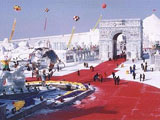 Often referred to as the City of Ice, Harbin is famous for its bitterly cold winters. At latitude of 46 degrees north, the city is frozen for four months of the year, and the temperature in winter drops to as low as minus 30 degrees centigrade.
Often referred to as the City of Ice, Harbin is famous for its bitterly cold winters. At latitude of 46 degrees north, the city is frozen for four months of the year, and the temperature in winter drops to as low as minus 30 degrees centigrade.
But the bitter cold never cools the local people’s enthusiasm for enjoying the winter scenery and all kinds of winter activities. Having ice and snow everywhere for one third of the year, the locals really know how to make the best use of their wintry treasures: all is white, but their lives are as colorful as ever. They have developed their chilly city into the country’s major winter sports base and the home of unique ice and snow art.
To enhance the city’s image and boost its tourism industry, since 1985 the city has hosted the grand Harbin Ice and Snow Festival every year from January to February. The festival is now one of the most popular local festivals in China, as well as one of the largest ice and snow spectaculars in the world, making Harbin a favorite destination for numerous tourists from home and abroad to spend their winter holidays.
There’s all sorts of things for them to do during the festival: skating, skiing, tobogganing, ice sailing, ice hockey, or simply enjoying the winter scenery.
But a highlight of the festival is the ice lantern and sculpture exhibitions, which provide visitors a good opportunity to appreciate a galaxy of unique ice and snow art. Thousands of exquisitely-made ice lanterns, ice carvings and snow sculptures grace the snow-covered parks, public squares and major streets, turning the city into a dreamlike world of pure whiteness and gleaming crystal.
These ice and snow art works come in all shapes and sizes. They can be as small as a mouse or as big as a bus. The designs range from life-size human figures, animals and flowers to towering castles, delicate pagodas and many other ingenious creations. Some of the most impressive are the intricately detailed replicas of famous buildings, such as the Potala Palace and the Eiffel Tower. And we mustn’t forget the Great Wall!
The ice lanterns and sculptures are illuminated inside with colored lights and lamps. By day, they sparkle like crystal in the winter sunshine. When the night curtain falls, they gently glow, a spectrum of gorgeous colors glistening against the dark sky.
And there’s plenty of fun activities for the more energetic. At 20 or 30 degrees below zero, even fur lined boots, long johns and thick down jackets might not suffice to keep you warm. No problem. Warm up with a brisk walk to the Songhua River, which winds through the northern part of the city.
The Songhua river in winter is no less bustling than a summer bathing beach. It’s frozen hard with ice nearly one meter thick, turning it into a huge playground for all kinds of ice sports. You can go skating and ice sailing, or ride in ice junks or horse-drawn sleighs. But if you want to do something really different, why not get into a swimming costume and join those crazy people, young and old, diving and swimming in a pool of icy water dug out of the frozen river. These human polar bears say it’s very good for the health, very invigorating. I thought of giving it a try – for about half a second, then I decided the hot tub back at the hotel would be better for my particular body type!
Having overcome my very short-lived temptation to dive into zero degree water, I headed out to the Yabuli Ski Resort, nestled in snow-covered mountains in the eastern outskirts of Harbin.
Yabuli is the largest and best place to ski in China, and was the venue for the third Asian Winter Sports Games in 1996. Needless to say, it’s a pretty busy place in winter, but never seems to get too crowded on the slopes.
With slopes ranging from easy to “no way!” and a number of mountain and cross-country skiing trails, the resort caters to the needs of different skiers, from people like me who spend more time falling over than skiing, to those frustrating people who make it all look so easy as they nonchalantly whiz down the steepest slopes.
Well, that’s covered many of the things you can do in Harbin in winter. But before I go I must mention some of the city’s scenic spots, such as Stalin Park, the Botanical Garden and Sun Island. And architecture buffs will love strolling around the many old buildings in various European architectural styles.
Finally, being a major city in northeast China, Harbin has convenient air and rail connections with many big cities across the country. Naturally, you can find all kinds of hotels here to suit different budgets. But if you plan to go during the ice festival, it’s probably best to book your accommodation in advance. Happy traveling!
(CRI November 27, 2002)
|

